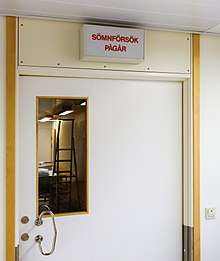Sleep study
A sleep study is a test that records the activity of the body during sleep. There are five main types of sleep studies that use different methods to test for different sleep characteristics and disorders. These include simple sleep studies, polysomnography, multiple sleep latency tests (MSLTs), maintenance of wakefulness tests (MWTs), and home sleep tests (HSTs). In medicine, sleep studies have been useful in identifying and ruling out various sleep disorders. Sleep studies have also been valuable to psychology, in which they have provided insight into brain activity and the other physiological factors of both sleep disorders and normal sleep. This has allowed further research to be done on the relationship between sleep and behavioral and psychological factors.

Utility
Depending on the method being used, sleep studies can help diagnose or rule out the following disorders:
- Sleep-related breathing disorders, such as sleep apnea[1][2]
- Sleep-related seizure disorders[1]
- Sleep-related movement disorders, such as periodic limb movement disorder, which is repeated muscle twitching of the feet, legs, or arms during sleep.[2][1] Sleep studies may be used to diagnose or rule out restless legs syndrome (RLS). However, RLS usually is diagnosed based on signs and symptoms, medical history, and a physical exam.[1]
- Problems sleeping at night (insomnia): caused by stress, depression, hunger, physical discomfort, or other problem.[2]
- Sleep disorders that cause extreme daytime tiredness, such as narcolepsy[1][2] or circadian rhythm sleep disorders.
- Problems with nighttime behaviors, such as sleepwalking, night terrors, or bed-wetting
- Bruxism or grinding of the teeth during sleep
- Problems sleeping during the day because of working at night or rotating shift work. This sleep problem is called shift work sleep disorder.[2]
- Sleep studies can also determine problems with stages of sleep. The two primary categories of sleep are non-rapid eye movement (NREM) and rapid eye movement sleep (REM). Normally, four to five series of NREM and REM make up a night's sleep. A change in this cycle may make it hard to sleep soundly.[2]
Types
The most common sleep studies are:
Polysomnogram
Polysomnography records several body functions during sleep, including brain activity, eye movement, oxygen and carbon dioxide blood levels, heart rate and rhythm, breathing rate and rhythm, the flow of air through the mouth and nose, snoring, body muscle movements, and chest and belly movement.[2] These tests are typically done at night in a hospital or sleep center. Polysomnogram tests can give insight into what is going wrong with an individuals sleep and why the issue is occurring.[3]
Multiple sleep latency test (MSLT)
The MSLT measures, by several nap opportunities in one day, how long it takes a person to fall asleep. It also determines whether REM sleep appears upon falling asleep.[2][4] It is usually performed immediately after an overnight study. This test is the standard to test for narcolepsy and idiopathic hypersomnia.[5]
Maintenance of wakefulness test (MWT)
This test measures whether a person can stay awake during a time when she or he is normally awake.[2][4] Like the MSLT, the MWT is performed in a sleep diagnostic center over 4 - 5 nap periods. A mean sleep onset latency of less than 10 minutes is suggestive of excessive daytime sleepiness.
Home sleep test (HST)
These typically include the individual whose sleep is being studied receiving a portable monitor and may include other items such as a finger clip and an airflow sensor. Items measured include oxygen saturation, heart rate, airflow, body movement, time spent snoring, sleep position, and brain waves.[6]
Sleep study in psychology
Sleep studies have been imperative for the empirical research of sleep psychology. The area of sleep psychology evaluates the physiological, and behavioral factors of normal sleep and sleep disorders along with the neuroscience and brain-wave activity associated with sleep, as well as the study of circadian rhythms.[7]
Administers of sleep studies
Sleep Specialists are doctors that are board certified in sleep medicine. Doctors qualified to order a sleep study include:
A doctor who provides first contact for a person with a health concern.[8]
Board-certified sleep medicine doctors have undergone special training and testing to ensure they can diagnose all sleep-related disorders, including sleep apnea.[9]
The neurologist treats disorders that affect the brain, spinal cord, and nerves.[10]
A medical practitioner specializing in the diagnosis and treatment of mental illness.[11]
References
- "Sleep Studies | National Heart, Lung, and Blood Institute (NHLBI)". www.nhlbi.nih.gov. Retrieved 2019-04-26.
- "Sleep Disorder Diagnosis Through a Sleep Study". WebMD. Retrieved 2019-04-26.
- "Polysomnography (sleep study) - Mayo Clinic". www.mayoclinic.org. Retrieved 2019-04-18.
- "Medicaid Policies".
- "Multiple Sleep Latency Test - Overview and Facts". sleepeducation.org. Retrieved 2019-04-18.
- "Do At Home Sleep Studies Really Work". Sleep.org. Retrieved 2019-04-18.
- "Sleep Psychology". https://www.apa.org. Retrieved 2019-04-18. External link in
|website=(help) - Primary care physician
- "What is a Sleep Specialist?"
- "What is a Neurologist?"
- "Medical Definition of Psychiatrist"
External sources
- Sleep Studies on National Sleep Foundation website
- E/M Coding and the Documentation Guidelines: Putting It All Together on AAFP website